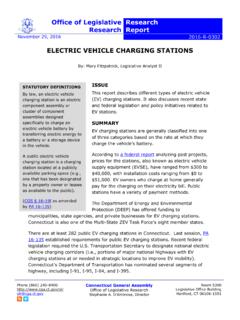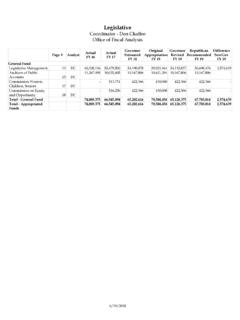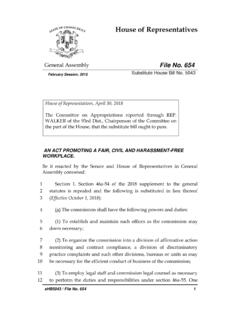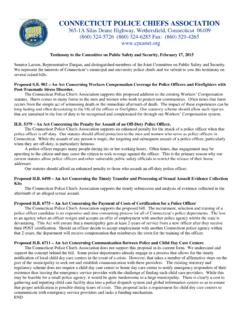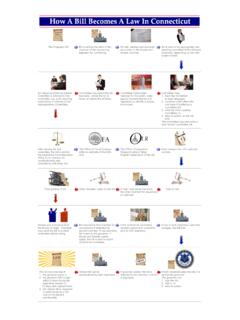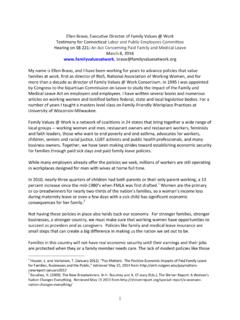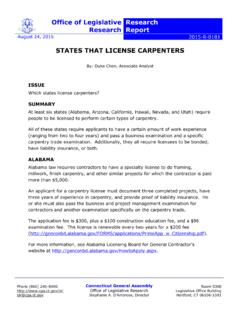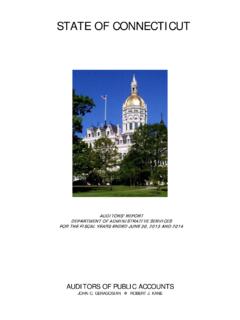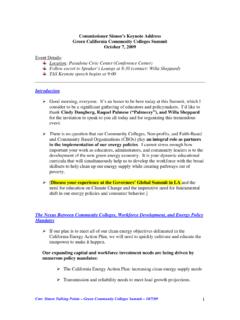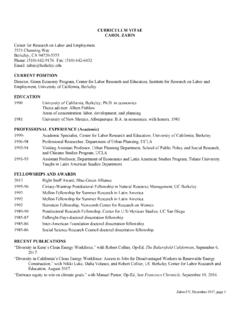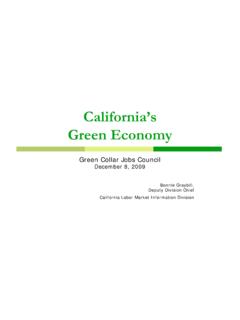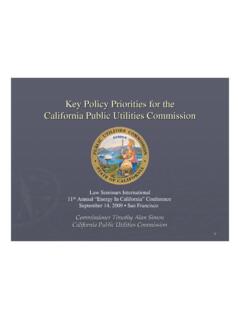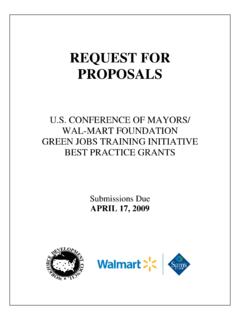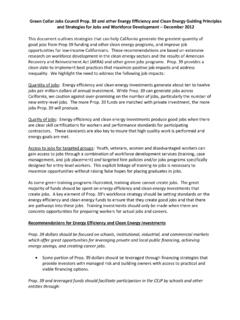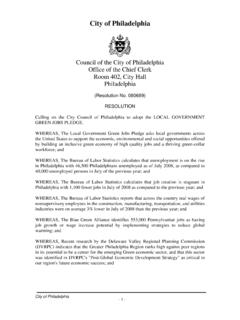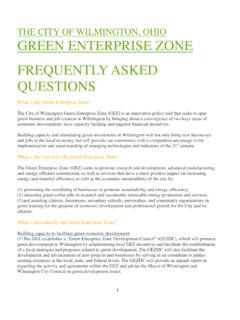Transcription of Legislative Program Review and Investigations Committee ...
1 Legislative Program Review and Investigations Committee examination of green collar jobs in Connecticut Presented to the Speaker s green jobs Coordination and Policy Committee January 7, 20102 The Four D s of Connecticut s green collar FieldzDrivingthe green movementzDefininggreen collar jobszDevelopingthe green collar field & future job opportunitieszDeliveringeducation & training for green collar jobs3 What is driving CT s green movement? GovernmentzGovernor/Executive Order No. 23zCT LegislaturezPrivate Sector4 Government is driving the green movementzConnecticut has already received $120 million in ARRA grantszSupporting training in:zNew green building codezSolar energy technologieszPrecision manufacturing zWeatherization5CT Employment and Training Commission (CETC)Connecticut Energy Sector Partnership(CETC Subcommittee)RoleDevelop State Energy Sector Strategic PlanGuide and Monitor Plan ImplementationMembership (* = current green jobs council member)CETC*Workforce Investment Boards*One StopsSDE*, DHE*, DEP*, DOL*, DECD*, OPM*Community Colleges*CT Clean Energy Fund*Labor organizations CT AFL CIO*Energy efficiency and renewable energy industry representatives and CBIA from Energy ConsortiumDSS and/or CT Assn for Community Action (for weatherization connection)
2 State apprenticeship agenciesLegislative representativesEnergy Workforce Development ConsortiumRoleAdvise CT Energy Sector PartnershipAssess and define industry skill needsMembership (* = green jobs council member)Energy related industry representativesWorkforce Investment Boards*One StopsLabor organizations*Community Colleges*Technical High SchoolsOther?Energy Consortium CommitteesBusiness and EducationCareer DevelopmentCT OWCM anagement & StaffingCBIACETC MemberManagement & StaffingCETC member co-chairs both groupsGovernor s Executive Order No. 23: Connecticut Energy Sector Partnership Structure(formerly Connecticut green collar jobs council )6 Recent CT statutory changes are driving the green movementConnecticut is the first state with a required green building code for public and private buildings7 How are green collar jobs being defined?
3 DOLzCT DOL/DECDzDCP LicensingzNational Certifying Organizations8 green collar jobs can fall into one of three categories:zGreen increased demandoccupations( , chemical engineers)zGreen enhanced skillsoccupations( , plumbers)zGreen new and emergingoccupations( , carbon trading analysts)9 Table I-5. Energy Efficiency and Renewable Energy TechnologiesEnergy Efficiency TechnologiesRenewable Energy Technologies High efficiency heating, ventilation, and air conditioning Efficient lighting Efficient home appliances Water heating Pumps, motors, and drives Building envelope Fuel cells Solar (PV and solar hot water) Wind Geothermal Hydrogen Power grid infrastructureSource: Connecticut Renewable Energy/Energy Efficiency Economy Baseline Study, Phase 1 Deliverable: Full Report, March 27, 2009, by Navigant Consulting, is developing the green collar field and where will the job opportunities be?
4 ZCT DOL, WIBSzDSS, CAP AgencieszCETC/OWCzCBIAzPrivate green companies11 Table I-12. Growth in Connecticut s green OccupationsOccupationEstimated # Employed in 2006 Projected # Employed in 2016 DemandHydrologist97121 25%Geoscientist174209 20%Environmental Engineer747891 19%Environ. Science & Protection 17%Environmental Engineering Technician216248 15%Natural Sciences Manager9331,062 14%Water & Liquid Waste Treatment Plant & System Operator856955 12%Environ. Scientist & Specialist685761 11%Nuclear Power Reactor Operator108113 5%Total5,4936,148 12%Regardless of the methodology used to define green collar jobs , all show a future increase in green is green collar job education and training being delivered?zHigher EducationzTechnical High SchoolszConnecticut Proprietary Schools13 Level of education required by green collar High Skill (98,434) Middle Skill (137,072) Low Skill (269,288)Source: CT DOL Occupations in a green Industry Report, April I-3.
5 Educational and Skill Level of green collar JobsOver half of green collar jobs may not require any postsecondary education14 Apprenticeships Weatherization Specialists Envelope Specialists Energy Auditors/Diagnosticians Energy Improvement Contractor Business Management or Entrepreneur Building Operators Figure III- .Potential green collar Career Ladder Source: Building a green collar Workforce, The Institute for Sustainable Energy at Eastern Connecticut State University. 15 Higher ed is helping prepare the green workforce in several ways:1. Offering majors or minors in directly related fields2. Offering majors or minors associated with the green movement3. Establishing centers or institutes4. Offering certificates5.
6 Offering individual courses16 Technical High Schools are helping to prepare the green workforce in several ways:zTraining students to install wind turbineszOffering bioscience and environmental technology programzWorking with community colleges to develop career pathszLearning for Clean Energy Innovation program17 green Workforce Development Barriers Related To: zElementary and secondary schoolzPostsecondary education institutionszDifficulty in making accurate projectionszCurrent economic challengeszState agency organization, programs, and policies18 Possible barrier related to elementary and secondary schoolLack of awareness or understanding of what green collar jobs areWherever possible, explain green collar jobs using the Department of Labor taxonomy and EE/RE categorization (Rec.)
7 #1)19 Possible barriers related to postsecondary education institutionsLack of uniformity in naming of green certificate programsThe Connecticut Community College System should implement uniform naming of green certificate programs across all member colleges (Rec. #2)20 Possible barriers related to postsecondary education institutionsNo central repository for the many green initiatives emerging across higher educationThe Connecticut Employment and Training Commission and the Connecticut Energy Sector Partnership should develop repository of green efforts (Rec. #3)21 Possible barrier related to difficulty in making accurate demand projectionszGreen collar jobs are just emerging and the official coding system has not yet caught up with these green occupationszUntil the green field is better defined, it will be difficult to make accurate demand projectionszA recently awarded ARRA grant will address some of the challenges in making accurate demand projections22 Possible barriers related to current economic challengesFew resources apart from ARRA stimulus funds to purchase the expensive equipment required to train studentsEducational systems should develop agreements to share equipment (Rec #4)
8 23 Possible barriers related to current economic challengesLack of career ladders/lattices to move individuals out of entry-level green collar jobs that are dependent on temporary ARRA fundingConnecticut postsecondary education institutions and state workforce development agencies should create career ladders (Rec. #5)24 Possible barriers related to state agency organization, programs, and policiesLack of awareness by colleges of green efforts occurring within other colleges in different higher education systemsThe Departments of Higher Education and Education should prepare an annual cross-system list of green offerings and of inventory of green - related equipment. (Rec. #6)25 Possible barriers related to state agency organization, programs, and policiesSometimes institutions are unaware of green efforts occurring within colleges in different higher education systemsStaff from Center for Clean Energy and the Institute for Sustainable Energy should meet to discuss possible collaborations on green initiatives.
9 (Rec. #7)26 For More Findings and Recommendations of the Alignment of Postsecondary Education and
